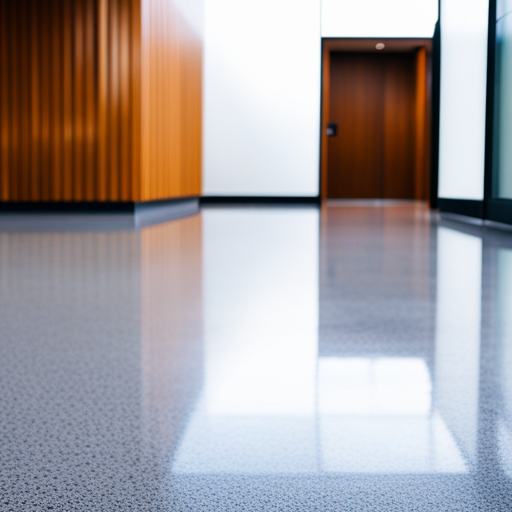Eco-Friendly Flooring and Green Building Certifications

Explore the intersection of eco-friendly flooring and green building certifications in this informative article.
Discover the diverse range of sustainable flooring materials and the benefits of selecting green building certifications for your construction projects.
Uncover the impact of eco-friendly flooring on sustainability and gain insights into the various green building certifications available.
Learn how to make environmentally responsible flooring choices and enhance the sustainability of your building projects.
Types of Eco-Friendly Flooring Materials
When considering eco-friendly flooring materials for a green building project, it is important to explore the various options available to ensure sustainability and environmental responsibility.
Bamboo flooring is a popular choice due to its renewability as bamboo is a fast-growing grass that can be harvested without harming the plant.
Another eco-friendly option is recycled tile, which is made from reclaimed materials, reducing waste and the need for new resources. These materials not only offer environmental benefits but also provide durability and aesthetic appeal.
In addition to bamboo flooring and recycled tile, other renewable materials such as cork and reclaimed wood can contribute to eco-friendly flooring solutions. These materials are sourced in a sustainable manner, promoting responsible land use and reducing the carbon footprint associated with flooring production.
Low volatile organic compound (VOC) emissions are also a crucial consideration in eco-friendly flooring, as these emissions can have adverse effects on indoor air quality and human health.
Transitioning into the subsequent section about ‘benefits of choosing green building certifications’, it is evident that the selection of eco-friendly flooring materials plays a significant role in achieving sustainable and environmentally responsible building projects.
Benefits of Choosing Green Building Certifications
Green building certifications offer numerous benefits for environmentally conscious building projects. When considering the advantages of choosing green building certifications, two key aspects stand out prominently:
-
Cost Savings: Green building certifications often lead to long-term cost savings for building owners and occupants. By incorporating energy-efficient designs and sustainable materials, these certifications can significantly reduce operational costs, such as energy and water consumption. This not only benefits the environment but also results in reduced utility bills, making it a financially prudent choice in the long run.
-
Energy Efficiency: One of the primary benefits of green building certifications is the emphasis on energy efficiency. Such certifications ensure that buildings are designed to consume less energy, thereby reducing their carbon footprint. Through the use of efficient lighting, heating, cooling, and insulation systems, these certifications contribute to a greener and more sustainable environment.
Transitioning to the subsequent section about the ‘impact of eco-friendly flooring on sustainability’, it is essential to recognize how the choice of flooring materials plays a crucial role in the overall sustainability of a building.
Impact of Eco-Friendly Flooring on Sustainability
The choice of eco-friendly flooring materials plays a crucial role in the overall sustainability of a building, as it directly impacts the environmental footprint and long-term operational efficiency. Incorporating eco-friendly flooring options such as bamboo, cork, reclaimed wood, or recycled materials can significantly reduce the environmental impact of a building.
These sustainable flooring choices are often produced using environmentally friendly processes, reducing energy consumption, carbon emissions, and the depletion of natural resources. Additionally, eco-friendly flooring can improve indoor air quality, contributing to the health and well-being of building occupants. The use of such flooring materials also supports sustainable forestry and reduces waste by utilizing recycled materials.
From a long-term perspective, eco-friendly flooring can lower maintenance and replacement costs, further enhancing the sustainability benefits. Understanding the environmental impact of flooring choices is paramount in achieving a sustainable built environment.
In the subsequent section, we will delve into the comparison of different green building certifications to provide a comprehensive understanding of their importance in sustainable construction.
Comparison of Different Green Building Certifications
As we explore the comparison of different green building certifications, it is crucial to understand the specific criteria and benchmarks utilized by each certification program to evaluate the sustainability and environmental performance of buildings.
Two prominent certifications, LEED (Leadership in Energy and Environmental Design) and BREEAM (Building Research Establishment Environmental Assessment Method), are widely recognized globally.
- LEED vs. BREEAM
LEED, developed by the U.S. Green Building Council, is widely used in the United States and has gained international popularity. It focuses on energy savings, water efficiency, CO2 emissions reduction, improved indoor environmental quality, and stewardship of resources.
BREEAM, originating from the UK, is prominent in European countries. It emphasizes sustainable value across the built environment, addressing a range of environmental and social aspects such as energy and water use, health and well-being, pollution, transport, materials, waste, ecology, and management processes.
Green building standards vary across countries due to differing environmental priorities, regulations, and building practices. While LEED and BREEAM are popular, other countries have their own systems, such as Green Star in Australia and CASBEE in Japan, indicating the diverse approaches to assessing and promoting sustainable construction practices worldwide.
Considerations for Selecting Environmentally Responsible Flooring
When choosing environmentally responsible flooring, it is important to consider the long-term environmental impact and sustainability of the materials. Installation methods, durability, maintenance, and cost effectiveness are crucial factors to consider when selecting environmentally responsible flooring.
The installation method of a flooring material can significantly impact its environmental footprint. Opting for materials that require less energy-intensive installation processes, such as adhesives with low volatile organic compounds (VOCs) or interlocking systems that eliminate the need for adhesives altogether, can contribute to a more sustainable choice.
Additionally, the durability of the flooring material is essential in minimizing its environmental impact over time. Selecting durable materials that can withstand heavy foot traffic and require fewer replacements can reduce the overall environmental burden.
Maintenance is another aspect to consider, as choosing flooring that is easy to clean and requires minimal chemical treatments can contribute to a more environmentally responsible choice.
Lastly, while cost effectiveness is important, it should be balanced with the long-term environmental benefits of the flooring material.
Frequently Asked Questions
Are There Any Tax Incentives or Rebates Available for Choosing Eco-Friendly Flooring or Obtaining Green Building Certifications?
Tax incentives and rebates for eco-friendly flooring and green building certifications can provide financial benefits to individuals and businesses. These incentives aim to promote sustainability and energy efficiency, offering potential cost savings and environmental benefits.
How Does the Installation and Maintenance of Eco-Friendly Flooring Compare to Traditional Flooring Options?
When comparing the installation and maintenance of eco-friendly flooring to traditional options, durability and cost-effectiveness stand out. The eco-friendly flooring exhibits resilience akin to a well-built fortress, proving to be a wise investment.
Can Eco-Friendly Flooring Materials Be Recycled at the End of Their Lifespan, and Are There Any Programs for Recycling or Reusing These Materials?
Recycling programs for eco-friendly flooring materials are increasingly available, offering a sustainable end-of-life solution. Reusing initiatives complement these efforts, promoting a circular economy and reducing environmental impact. Such programs contribute to the overall sustainability of flooring solutions.
Are There Any Potential Health Benefits to Using Eco-Friendly Flooring, Such as Improved Indoor Air Quality or Reduced Exposure to Harmful Chemicals?
When considering flooring options, it’s crucial to prioritize health benefits such as improved indoor air quality and reduced exposure to harmful chemicals. These factors contribute to a healthier living environment and may even qualify for tax incentives.
What Are Some Common Misconceptions or Myths About Eco-Friendly Flooring and Green Building Certifications That Consumers Should Be Aware Of?
Common misconceptions about eco-friendly flooring and green building certifications may include assumptions about higher costs, lower durability, and limited style options. It’s important for consumers to consider the environmental impact, cost, and longevity of such products.
Conclusion
In conclusion, eco-friendly flooring materials and green building certifications play a crucial role in promoting sustainability and environmental responsibility in the construction industry.
By choosing environmentally responsible flooring and obtaining green building certifications, builders and homeowners can significantly reduce their carbon footprint and contribute to a healthier planet.
The impact of these choices is not just important, it’s earth-shatteringly significant.

Rubin Everest, a seasoned expert in the world of flooring, brings a wealth of knowledge and passion to the surface. As the mind behind ebbow.com, Rubin is dedicated to sharing insights on the latest trends, innovative solutions, and expert advice in the realm of flooring. Whether you’re seeking practical tips for installation or design inspiration, Rubin Everest is your go-to source for all things flooring-related, making your journey to the perfect floor an informed and enjoyable experience.





